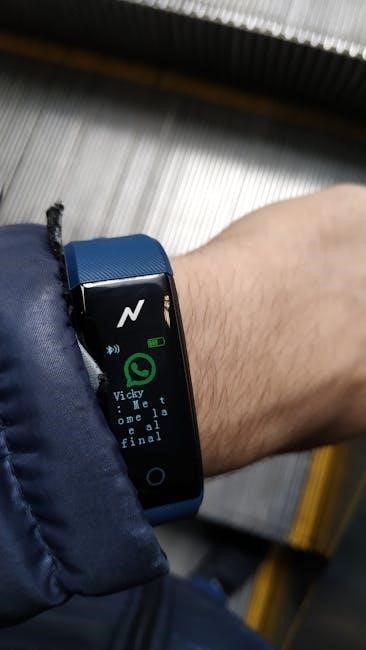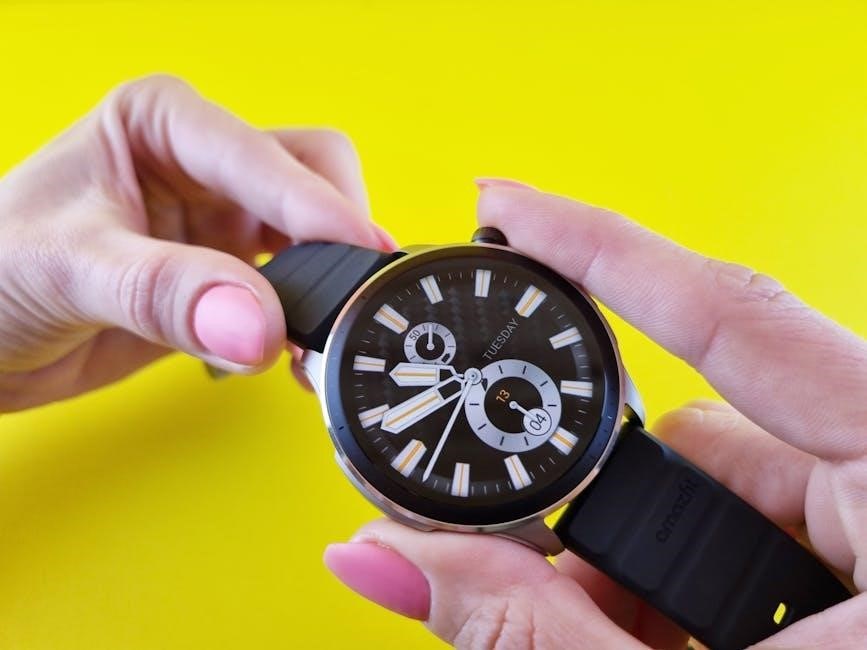Watch batteries come in various sizes to fit different timepieces. Correct sizing ensures optimal performance and longevity. Common types include silver-oxide and alkaline batteries, each designed for specific watches.
1.1 Importance of Correct Battery Size
Using the correct battery size is crucial for your watch’s performance and longevity. A improperly sized battery can cause poor functionality, leakage, or even complete malfunction. Ensure the battery fits perfectly to maintain accurate timekeeping and avoid damage. Always verify the voltage and chemistry match your watch’s requirements for optimal performance.
1.2 Common Watch Battery Types
Popular watch batteries include silver-oxide types like SR920SW and SR626SW, known for their reliability and long life. Alkaline batteries, such as CR2016 and CR2032, are widely used due to their affordability and compatibility with various devices. Both types are available in standard sizes, ensuring easy replacements and consistent performance across different watch models and brands.

How to Identify the Correct Battery Size
Reading the battery code on the watch’s back, such as SR920SW or CR2016, helps ensure the correct replacement size for optimal performance.
2.1 Checking the Watch Manual
To identify the correct battery size, start by consulting your watch’s manual. Most manuals specify the recommended battery type and size. If the manual is unavailable,
check the manufacturer’s official website or search online using the watch model number. This ensures you find the exact battery size and type
required for optimal performance and longevity.
2.2 Using a Battery Dimensions Chart
A battery dimensions chart is a valuable tool for identifying the correct battery size. These charts provide detailed measurements, including diameter, height, and voltage, for various battery types. They often include cross-references to equivalent batteries, making it easier to find compatible replacements. By comparing your watch’s battery compartment dimensions with the chart, you can accurately determine the right size and type of battery needed for your timepiece.
2.3 Measuring the Battery Compartment
Measuring the battery compartment is a straightforward method to determine the correct size. Use calipers or a ruler to measure the diameter and height of the compartment. Compare these measurements with a battery dimensions chart to identify the matching size. Ensure accuracy to avoid selecting the wrong battery, as improper fit can affect performance or damage the watch. This step is crucial when the manual or battery code is unavailable.

Understanding Watch Battery Codes
Watch battery codes like SR920SW or CR2016 indicate size, voltage, and chemistry. These codes help identify the correct replacement battery for optimal performance and compatibility.
3.1 Decoding Battery Codes (e.g., SR920SW, CR2016)
Watch battery codes like SR920SW and CR2016 provide essential information. The prefix (SR/CR) indicates the battery type: Silver Oxide or Alkaline. The numbers represent dimensions in millimeters, with the first two digits as diameter and the last two as height. The suffix (W/SW) denotes low or high drain. These codes help in selecting the correct battery size and type for your watch, ensuring compatibility and optimal performance. Using a cross-reference guide can help find equivalents if the exact code isn’t available, making it easier to replace batteries without compromising your watch’s functionality. Understanding these codes is crucial for maintaining your timepiece’s accuracy and longevity.
3.2 Cross-Reference Guides for Equivalents
Cross-reference guides are invaluable for identifying equivalent watch batteries. These charts list popular battery codes and their compatible alternatives, ensuring proper fit and performance. For example, SR920SW and CR2016 are common equivalents in many guides. By comparing dimensions, voltage, and chemistry, users can easily find suitable replacements. This resource is especially useful when the exact battery code is unavailable, ensuring your watch continues to function accurately and reliably without compromise.

Common Watch Battery Sizes
Popular watch batteries include SR626SW, SR920SW, CR2016, and CR2032. These sizes are widely used in quartz watches, offering reliable power for accurate timekeeping and functionality.
4.1 SR626SW, SR920SW, and Other Popular Sizes
SR626SW and SR920SW are widely used silver-oxide batteries, known for their reliability and 1.55V voltage. These compact sizes fit many quartz watches, offering long life. Other popular options include SR521SW and SR712SW, each designed for specific watch models. Their dimensions and capacities ensure compatibility across various timepieces, making them favorites among watch enthusiasts and professionals. Always verify size before replacement for optimal performance.
4.2 CR2016, CR2032, and Other Alkaline Batteries
CR2016 and CR2032 are popular alkaline batteries, widely used in watches, calculators, and remote controls. These 3V batteries are known for their long shelf life and consistent power delivery. CR2016 is smaller, while CR2032 offers higher capacity. Both are suitable for low-drain devices, with CR2032 being more versatile. Always check compatibility using a cross-reference chart to ensure proper fit and performance in your watch or device.

Watch Battery Replacement Guide
Replacing a watch battery involves opening the case, removing the old battery, and installing a new one of the correct size and type. Use proper tools to avoid damage.
5.1 Tools Needed for Battery Replacement
To replace a watch battery, you’ll need a few essential tools. Start with a watch case opener to remove the back. A small screwdriver may be required for screws. Plastic or metal tweezers can help handle the battery. A soft cloth prevents scratching the watch. For added precision, use a magnifying glass or loupe. Anti-static wrist straps are recommended to prevent damage from static electricity. Always use tools specifically designed for watch repair to avoid causing damage.
5.2 Step-by-Step Replacement Process
Begin by opening the watch case using a case opener or screwdriver. Gently remove the back and locate the battery compartment. Use tweezers to carefully lift out the old battery. Insert the new battery, ensuring it fits securely. Replace the case and tighten it properly. Test the watch to confirm it’s working. Handle the battery by the edges to avoid oil residue, and ensure all tools are clean to prevent damage or corrosion.

Watch Battery Cross-Reference Chart
A cross-reference chart lists equivalent battery codes and sizes, ensuring compatibility across brands. Use it to find alternatives for your watch’s specific battery type easily.
6.1 Finding Equivalent Batteries
Finding equivalent batteries is made easy with a cross-reference chart, which lists compatible alternatives for specific battery codes. For example, SR920SW can be replaced with SR920W, while CR2016 matches CR2032 in some cases. This guide helps users identify similar-sized batteries from different brands, ensuring proper fit and function. It’s especially useful when the original battery type is unavailable or discontinued. Always verify voltage and chemistry for compatibility.
6.2 Compatibility Across Brands
Watch batteries from brands like Maxell, Energizer, and Sony often have compatible equivalents, ensuring flexibility in replacement. For instance, SR920SW (Maxell) can be replaced with SR920W (Energizer), while CR2016 (Sony) matches CR2032 (Maxell) in size and voltage. Compatibility across brands allows users to find suitable replacements easily, maintaining their watch’s performance and longevity without being limited to a single brand.

Voltage and Chemistry of Watch Batteries
Watch batteries typically operate at 1.55V, with silver-oxide offering high energy for low-drain devices and alkaline suited for higher-drain applications, ensuring reliable power for various timepieces.
7.1 Silver-Oxide vs. Alkaline Batteries
Silver-oxide batteries, with 1.55V, are ideal for low-drain devices like analog watches, offering stable power and longevity. Alkaline batteries, also 1.55V, suit high-drain watches with additional features, providing reliable energy. Both types are widely used, ensuring optimal performance based on the watch’s specific needs and functionality requirements.
7.2 High-Drain vs. Low-Drain Batteries
High-drain batteries are designed for watches with advanced features like GPS or alarms, requiring more power. Low-drain batteries suit simple analog watches with minimal energy needs. Both typically operate at 1.55V but differ in discharge rates. Choosing the right type ensures optimal performance and extends battery life, preventing premature depletion caused by mismatched energy demands and usage patterns.

Top Watch Battery Brands
Leading brands like Maxell, Energizer, and Sony are renowned for their high-quality watch batteries. These brands offer reliable performance and durability, catering to various watch types and needs.
8.1 Maxell, Energizer, and Sony
Maxell, Energizer, and Sony are leading manufacturers of high-quality watch batteries. Maxell is recognized for its innovative mercury-free silver-oxide batteries, while Energizer offers long-lasting alkaline options. Sony provides reliable energy solutions with its SR series, trusted by watch enthusiasts worldwide. These brands ensure optimal performance, durability, and compatibility across various timepiece models, making them top choices for both everyday and premium watches.
8.2 Murata and Seiko Batteries
Murata and Seiko are renowned for their high-performance watch batteries. Murata specializes in advanced battery technologies, offering reliable energy solutions for various watch models. Seiko, a trusted name in horology, produces batteries that align perfectly with their timepieces, ensuring longevity and efficiency. Both brands emphasize quality and innovation, catering to both traditional and modern watches, and are favored by professionals and enthusiasts for their consistent performance and durability.

Troubleshooting Common Battery Issues
Identifying issues like incorrect battery size or poor performance can be resolved by checking the manual or using a battery dimensions chart for accurate solutions.
9.1 Identifying the Wrong Battery Size
Signs of using the wrong battery size include poor fit in the compartment, inconsistent contact, and malfunctioning watch features. If the battery doesn’t align properly or the watch functions irregularly, it may be the incorrect size. Additionally, rapid draining or leakage can indicate a mismatched battery type or size, requiring immediate replacement with the correct specifications.
9.2 Battery Life and Performance Problems
Battery life issues often arise from incorrect size or type, leading to short lifespan or poor performance. High-drain watches may drain batteries faster, while low-quality or old batteries struggle to maintain power. Environmental factors like extreme temperatures can also degrade performance. If a battery fails to power the watch or drains quickly, it may be incompatible or nearing its end. Always use the recommended size and type to ensure optimal longevity and functionality.

Best Practices for Battery Maintenance
Store unused batteries in a cool, dry place to prevent degradation. Avoid over-tightening the watch case, as this can damage the battery compartment and affect performance.
10.1 Storage Tips for Unused Batteries
Store unused watch batteries in a cool, dry environment away from metal objects to prevent discharge. Use protective packaging or original cases to avoid damage. Keep them out of reach of children and pets. Proper storage ensures longevity and maintains battery performance when needed. Always check expiration dates before use and avoid mixing old and new batteries.
10.2 Avoiding Over-Tightening the Watch Case
Avoid over-tightening the watch case to prevent damage to the gaskets or battery compartment. Use a case opener or wrench designed for your watch type. Apply even pressure and ensure the case aligns properly before securing it. Over-tightening can lead to water ingress or internal damage. Always follow manufacturer guidelines for torque specifications to maintain your watch’s integrity and functionality.
